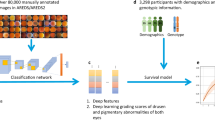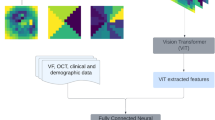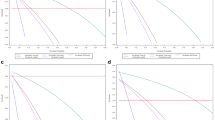Abstract
Background
Retinoblastoma is the most common intraocular malignancy in childhood. With the advanced management strategy, the globe salvage and overall survival have significantly improved, which proposes subsequent challenges regarding long-term surveillance and offspring screening. This study aimed to apply a deep learning algorithm to reduce the burden of follow-up and offspring screening.
Methods
This cohort study includes retinoblastoma patients who visited Beijing Tongren Hospital from March 2018 to January 2022 for deep learning algorism development. Clinical-suspected and treated retinoblastoma patients from February 2022 to June 2022 were prospectively collected for prospective validation. Images from the posterior pole and peripheral retina were collected, and reference standards were made according to the consensus of the multidisciplinary management team. A deep learning algorithm was trained to identify “normal fundus”, “stable retinoblastoma” in which specific treatment is not required, and “active retinoblastoma” in which specific treatment is required. The performance of each classifier included sensitivity, specificity, accuracy, and cost-utility.
Results
A total of 36,623 images were included for developing the Deep Learning Assistant for Retinoblastoma Monitoring (DLA-RB) algorithm. In internal fivefold cross-validation, DLA-RB achieved an area under curve (AUC) of 0.998 (95% confidence interval [CI] 0.986–1.000) in distinguishing normal fundus and active retinoblastoma, and 0.940 (95% CI 0.851–0.996) in distinguishing stable and active retinoblastoma. From February 2022 to June 2022, 139 eyes of 103 patients were prospectively collected. In identifying active retinoblastoma tumours from all clinical-suspected patients and active retinoblastoma from all treated retinoblastoma patients, the AUC of DLA-RB reached 0.991 (95% CI 0.970–1.000), and 0.962 (95% CI 0.915–1.000), respectively. The combination between ophthalmologists and DLA-RB significantly improved the accuracy of competent ophthalmologists and residents regarding both binary tasks. Cost-utility analysis revealed DLA-RB-based diagnosis mode is cost-effective in both retinoblastoma diagnosis and active retinoblastoma identification.
Conclusions
DLA-RB achieved high accuracy and sensitivity in identifying active retinoblastoma from the normal and stable retinoblastoma fundus. It can be used to surveil the activity of retinoblastoma during follow-up and screen high-risk offspring. Compared with referral procedures to ophthalmologic centres, DLA-RB-based screening and surveillance is cost-effective and can be incorporated within telemedicine programs.
Clinical Trial Registration
This study was registered on ClinicalTrials.gov (NCT05308043).
This is a preview of subscription content, access via your institution
Access options
Subscribe to this journal
Receive 24 print issues and online access
$259.00 per year
only $10.79 per issue
Buy this article
- Purchase on Springer Link
- Instant access to full article PDF
Prices may be subject to local taxes which are calculated during checkout




Similar content being viewed by others
Data availability
The data in this study are available from the corresponding author upon reasonable request.
Materials availability
The materials in this study are available from the corresponding author upon reasonable request.
Code availability
Python scripts enabling the main steps of the analysis are available from https://github.com/Hugo0512/AI4RB, and we provide some sample images for readers’ testing.
References
Dimaras H, Corson TW, Cobrinik D, White A, Zhao J, Munier FL, et al. Retinoblastoma. Nat Rev Dis Prim. 2015;1:15021.
Fabian ID, Onadim Z, Karaa E, Duncan C, Chowdhury T, Scheimberg I, et al. The management of retinoblastoma. Oncogene. 2018;37:1551–60.
Luo Y, Zhou C, He F, Fan J, Wen X, Ding Y, et al. Contemporary update of retinoblastoma in China: three-decade changes in epidemiology, clinical features, treatments, and outcomes. Am J Ophthalmol. 2022;236:193–203.
Linn Murphree A. Intraocular retinoblastoma: the case for a new group classification. Ophthalmol Clin North Am. 2005;18:41–53.
Stathopoulos C, Lumbroso-Le Rouic L, Moll AC, Parulekar M, Maeder P, Doz F, et al. Current indications of secondary enucleation in retinoblastoma management: a position paper on behalf of the European Retinoblastoma Group (EURbG). Cancers. 2021;13:3392.
Daniels AB, Patel SN, Milam RW, Kohanim S, Friedman DL, Koyama T. Effect of intravenous chemotherapy regimen on globe salvage success rates for retinoblastoma based on disease class-A meta-analysis. Cancers. 2021;13:2216.
Chen Q, Zhang B, Dong Y, Mo X, Zhang L, Huang W, et al. Comparison between intravenous chemotherapy and intra-arterial chemotherapy for retinoblastoma: a meta-analysis. BMC Cancer. 2018;18:486.
Fabian ID, Stacey AW, Johnson KC, Chowdhury T, Duncan C, Reddy MA, et al. Primary enucleation for group D retinoblastoma in the era of systemic and targeted chemotherapy: the price of retaining an eye. Br J Ophthalmol. 2018;102:265–71.
Dimaras H, Kimani K, Dimba EA, Gronsdahl P, White A, Chan HS, et al. Retinoblastoma. Lancet. 2012;379:1436–46.
Gulshan V, Peng L, Coram M, Stumpe MC, Wu D, Narayanaswamy A, et al. Development and validation of a deep learning algorithm for detection of diabetic retinopathy in retinal fundus photographs. JAMA. 2016;316:2402–10.
Peng Y, Dharssi S, Chen Q, Keenan TD, Agron E, Wong WT, et al. DeepSeeNet: a deep learning model for automated classification of patient-based age-related macular degeneration severity from color fundus photographs. Ophthalmology. 2019;126:565–75.
Li Z, He Y, Keel S, Meng W, Chang RT, He M. Efficacy of a deep learning system for detecting glaucomatous optic neuropathy based on color fundus photographs. Ophthalmology. 2018;125:1199–206.
Tan TE, Anees A, Chen C, Li S, Xu X, Li Z, et al. Retinal photograph-based deep learning algorithms for myopia and a blockchain platform to facilitate artificial intelligence medical research: a retrospective multicohort study. Lancet Digit Health. 2021;3:e317–9.
Milea D, Najjar RP, Zhubo J, Ting D, Vasseneix C, Xu X, et al. Artificial intelligence to detect papilledema from ocular fundus photographs. N Engl J Med. 2020;382:1687–95.
Brown JM, Campbell JP, Beers A, Chang K, Ostmo S, Chan RVP, et al. Automated diagnosis of plus disease in retinopathy of prematurity using deep convolutional neural networks. JAMA Ophthalmol. 2018;136:803–10.
Redd TK, Campbell JP, Brown JM, Kim SJ, Ostmo S, Chan RVP, et al. Evaluation of a deep learning image assessment system for detecting severe retinopathy of prematurity. Br J Ophthalmol. 2019;103:580–4.
Hui S, Dong L, Zhang K, Nie Z, Jiang X, Li H, et al. Noninvasive identification of benign and malignant eyelid tumors using clinical images via deep learning system. J Big Data. 2022;9:84.
Zhou W-D, Dong L, Zhang K, Wang Q, Shao L, Yang Q, et al. Deep learning for automatic detection of recurrent retinal detachment after surgery using ultra-widefield fundus images: a single-center study. Adv Intell Syst. 2022;4:2200067.
Pan Q, Zhang K, He L, Dong Z, Zhang L, Wu X, et al. Automatically diagnosing disk bulge and disk herniation with lumbar magnetic resonance images by using deep convolutional neural networks: method development study. JMIR Med Inform. 2021;9:e14755.
Zhang K, Liu X, Liu F, He L, Zhang L, Yang Y, et al. An interpretable and expandable deep learning diagnostic system for multiple ocular diseases: qualitative study. J Med Internet Res. 2018;20:e11144.
Li Z, Guo C, Nie D, Lin D, Zhu Y, Chen C, et al. Deep learning from “passive feeding” to “selective eating” of real-world data. NPJ Digit Med. 2020;3:143.
Shorten C, Khoshgoftaar TM. A survey on image data augmentation for deep learning. J Big Data. 2019;6:60.
Lu B, Li H-X, Chang Z-K, Li L, Chen N-X, Zhu Z-C, et al. A practical Alzheimer’s disease classifier via brain imaging-based deep learning on 85,721 samples. J Big Data. 2022;9:101.
Zhang M, Zhang K, Yu D, Xie Q, Liu B, Chen D, et al. Computerized assisted evaluation system for canine cardiomegaly via key points detection with deep learning. Prev Vet Med. 2021;193:105399.
Schmidt H, Spieker AJ, Luo T, Szymczak JE, Grande D. Variability in primary care physician attitudes toward medicaid work requirement exemption requests made by patients with depression. JAMA Health Forum. 2021;2:e212932.
Deng J, Dong W, Socher R, Li LJ, Kai L, Li F-F. ImageNet: a large-scale hierarchical image database. In: Proceedings of IEEE Conference on Computer Vision and Pattern Recognition. 2009. p. 248–55.
Bottou, L. Stochastic gradient descent tricks. In: Montavon G, Orr GB, Müller K-R, editors. Neural networks: tricks of the trade. Lecture Notes in Computer Science. Berlin: Springer; 2012. p. 421–36.
Skalet AH, Gombos DS, Gallie BL, Kim JW, Shields CL, Marr BP, et al. Screening children at risk for retinoblastoma: consensus report from the American Association of Ophthalmic Oncologists and Pathologists. Ophthalmology. 2018;125:453–8.
Hutubessy R, Chisholm D, Edejer TT-T. Generalized cost-effectiveness analysis for national-level priority-setting in the health sector. Cost Eff Resour Alloc. 2003;1:8.
Selvaraju RR, Cogswell M, Das A, Vedantam R, Parikh D, Batra D. Grad-CAM: visual explanations from deep networks via gradient-based localization. In: Proceedings of the IEEE International Conference on Computer Vision. 2017. p. 618–26.
Ramirez-Ortiz MA, Ponce-Castaneda MV, Cabrera-Munoz ML, Medina-Sanson A, Liu X, Orjuela MA. Diagnostic delay and sociodemographic predictors of stage at diagnosis and mortality in unilateral and bilateral retinoblastoma. Cancer Epidemiol Biomark Prev. 2014;23:784–92.
Wong ES, Choy RW, Zhang Y, Chu WK, Chen LJ, Pang CP, et al. Global retinoblastoma survival and globe preservation: a systematic review and meta-analysis of associations with socioeconomic and health-care factors. Lancet Glob Health. 2022;10:e380–89.
Munier FL, Beck-Popovic M, Chantada GL, Cobrinik D, Kivela TT, Lohmann D, et al. Conservative management of retinoblastoma: challenging orthodoxy without compromising the state of metastatic grace. “Alive, with good vision and no comorbidity”. Prog Retin Eye Res. 2019;73:100764.
Yousef YA, Al-Nawaiseh I, Mehyar M, Sultan I, Al-Hussaini M, Jaradat I, et al. How telemedicine and centralized care changed the natural history of retinoblastoma in a developing country: analysis of 478 patients. Ophthalmology. 2021;128:130–7.
Morrison SL, Dukhovny D, Chan RVP, Chiang MF, Campbell JP. Cost-effectiveness of artificial intelligence-based retinopathy of prematurity screening. JAMA Ophthalmol. 2022;140:401–9.
Funding
Beijing Hospitals Authority’ Ascent Plan (DFL20190201); National Natural Science Foundation of China (82141128); The Capital Health Research and Development of Special (2020-1-2052); Science & Technology Project of Beijing Municipal Science & Technology Commission (Z201100005520045, Z181100001818003). The sponsor or funding organisation had no role in the design or conduct of this research.
Author information
Authors and Affiliations
Contributions
JMM, RHZ, and DL contributed to the concept of the study. JMM and WBW critically reviewed the manuscript. RHZ, LD, RYL, KZ, and YTL designed the study and did the literature search. RHZ, LD, RYL, KZ, YTL, HSZ, JTS, XG, XLX, LBJ, XHS, CZ, WDZ, LYX, HTW, HYL, CYY, and JL collected the data. RHZ, LD, RYL, KZ, and YTL contributed to the design of the statistical analysis plan. RHZ, LD, and KZ did the data analysis and data interpretation. RHZ and RYL drafted the manuscript. JMM and WBW provided research funding, coordinated the research, and oversaw the project. All authors had access to all the raw datasets and the corresponding authors (JMM and WBW) verified the data and had the final decision to submit it for publication. All authors reviewed and approved the final manuscript.
Corresponding authors
Ethics declarations
Competing interests
The authors declare no competing interests.
Ethics approval and consent to participate
The Medical Ethics Committee of Beijing Tongren Hospital approved the study protocol. Because individually identifiable information was removed during retrospective collection, written informed consent was exempted from the retrospectively collected dataset. In the prospectively collected validation dataset, informed consent was obtained from all caregivers.
Consent for publication
All authors declare that all information and materials in the manuscript are original. No text, table, figure, or other material has been published elsewhere.
Additional information
Publisher’s note Springer Nature remains neutral with regard to jurisdictional claims in published maps and institutional affiliations.
Supplementary information
Rights and permissions
Springer Nature or its licensor (e.g. a society or other partner) holds exclusive rights to this article under a publishing agreement with the author(s) or other rightsholder(s); author self-archiving of the accepted manuscript version of this article is solely governed by the terms of such publishing agreement and applicable law.
About this article
Cite this article
Zhang, R., Dong, L., Li, R. et al. Automatic retinoblastoma screening and surveillance using deep learning. Br J Cancer 129, 466–474 (2023). https://doi.org/10.1038/s41416-023-02320-z
Received:
Revised:
Accepted:
Published:
Issue Date:
DOI: https://doi.org/10.1038/s41416-023-02320-z



